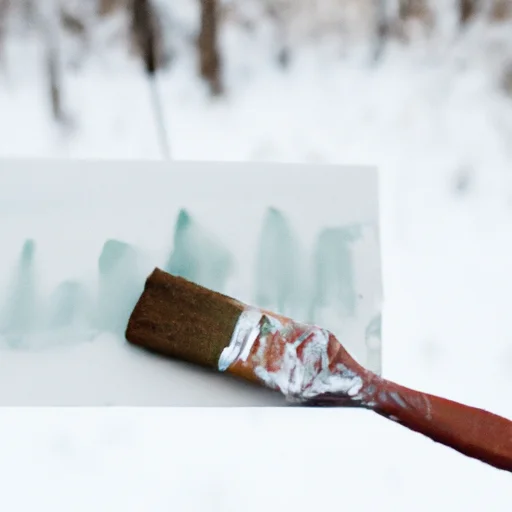Thinking about sprucing up your home’s exterior with a fresh coat of paint, but worried that winter weather might put a damper on your plans? Fear not, for we are here to shed some light on the age-old question: can you paint exterior in winter? In this article, we tackle this common inquiry and provide you with all the information you need to know about painting in chilly temperatures. So grab a cozy blanket and a hot cup of cocoa, and let us guide you through the ins and outs of winter painting.

Table of Contents
Can You Paint Exterior in Winter?
As the temperatures drop and winter weather sets in, many people wonder if it’s possible to paint the exterior of their homes during this time. The answer is yes, you can definitely paint the exterior in winter! However, there are certain factors to consider, ideal conditions to look out for, preparation steps to take, and special techniques to use in order to achieve the best results. In this article, we will explore all of these aspects and provide you with valuable tips and recommendations for painting in winter.

Factors to Consider Before Painting in Winter
Before diving into a winter painting project, it’s important to consider a few factors that could impact the overall quality and durability of your paint job. One of the main factors to keep in mind is the temperature. Most paints have a minimum temperature requirement for application, often stated on the paint can. It’s crucial to choose a paint that can withstand the cold temperatures of winter to ensure proper adhesion and drying.
Another factor to consider is the humidity levels. High humidity can affect how paint dries and can lead to issues such as bubbling or peeling. It’s advisable to check the humidity levels in your area before starting any painting project and choose a day with lower humidity if possible. Additionally, if you live in an area where winter brings frequent rain or snow, it’s important to plan your painting project during a dry spell to avoid any weather-related problems.
Ideal Conditions for Painting in Winter
While painting in winter is possible, it’s essential to have the right conditions for a successful project. The ideal temperature for exterior painting in winter is usually above 35 degrees Fahrenheit (1.6 degrees Celsius). It’s important to note that this temperature refers to the air and the surface being painted. In colder temperatures, the paint will not adhere properly and may take longer to dry.
In addition to the temperature, it’s crucial to choose a day with low humidity, preferably below 70 percent. High humidity can slow down the drying process, leading to poor adhesion and potential paint failure. It’s also best to avoid painting on days with strong winds, as it can cause paint to dry unevenly and create a messy finish.
Preparation Steps Before Painting in Winter
Proper preparation is key to a successful winter painting project. Before starting, it’s important to thoroughly clean the surface you plan to paint. Remove any dirt, grime, or loose paint using a scraper, brush, or pressure washer. This will ensure that the paint adheres well and provides a smooth finish. It’s also recommended to let the surface dry completely before proceeding with the painting process.
In addition to cleaning, consider applying a primer before painting. A primer helps to create a smooth and even surface for the paint to adhere to, enhances the durability of the paint, and can even help with color coverage. Make sure to choose a primer that is suitable for the surface you are painting and follow the manufacturer’s instructions for application and drying time.
Choosing the Right Paint for Winter
When it comes to choosing paint for winter, it’s important to select a product specifically designed for colder temperatures. Look for paints that are labeled “winter formula” or “cold weather paint.” These paints are formulated to withstand lower temperatures and will provide better adhesion and durability. Additionally, opt for paints with high-quality ingredients that offer resistance to moisture, mold, and mildew, as these factors can be more prevalent during the winter months.
Before purchasing paint, consider the type of surface you are painting. Different surfaces may require different types of paint, such as acrylic, latex, or oil-based. It’s important to choose a paint that is specifically made for the surface you are working on to ensure the best results. Additionally, consider the desired finish of your paint job, whether it be glossy, satin, or matte, and select a paint that offers the desired sheen.
Special Techniques for Painting in Winter
Painting in winter does require some special techniques to ensure a successful outcome. One of the most important techniques is to paint during the warmest part of the day. This allows the paint to dry faster and ensures better adhesion. It’s also important to avoid painting in direct sunlight, as it can cause the paint to dry too quickly and lead to issues such as brush marks or lap marks. Instead, choose a time when the surface is in the shade or paint on an overcast day.
Another technique to keep in mind is to thin the paint slightly. Cold weather can cause paint to become thicker, making it challenging to apply smoothly. By adding a small amount of water or paint thinner, you can improve the paint’s consistency and make it easier to work with. However, it’s important to follow the manufacturer’s instructions and not overthin the paint, as it can affect its performance and durability.
Benefits of Painting in Winter
While painting in winter may require some additional considerations, there are several benefits to tackling a painting project during the colder months. One of the main advantages is that professional painters are typically less busy during winter, which means you may be able to find a reputable contractor at a more affordable price. Additionally, you won’t have to deal with the heat and humidity that comes with painting in the summer months.
Another benefit of painting in winter is that the paint can dry more slowly, allowing for better adhesion and a smoother finish. This is especially true for oil-based paints, which tend to dry faster in warmer weather. By painting in winter, you give the paint more time to settle and bond with the surface, resulting in a longer-lasting and more durable finish.
Common Mistakes to Avoid when Painting in Winter
While painting in winter can yield great results, there are some common mistakes that should be avoided for a successful project. One of the most common mistakes is attempting to paint in extremely cold temperatures. If the temperature is below the recommended range stated on the paint can, the paint may not dry properly, leading to poor adhesion and potential peeling or cracking. Always check the temperature requirements and avoid painting in excessively cold conditions.
Another mistake to avoid is rushing the drying process. While it may be tempting to speed up the drying time by using heaters or fans, this can actually lead to issues such as uneven drying and bubbling. It’s important to allow the paint to dry naturally, following the recommended drying time stated on the paint can. If necessary, consider using a heat lamp specifically designed for drying paint, but be sure to follow the manufacturer’s instructions and use caution.
Tips to Ensure Successful Painting in Winter
To ensure a successful painting project in winter, here are some additional tips to keep in mind:
- Check the weather forecast: Before starting your project, check the weather forecast to make sure you have a few consecutive days of favorable conditions.
- Protect yourself from the cold: Dress warmly and wear proper protective gear, such as gloves and a hat, to stay comfortable and safe while painting in colder temperatures.
- Use a high-quality brush or roller: Invest in high-quality painting tools to ensure a smooth and even application of paint.
- Store paint properly: If you need to take breaks during your painting project, make sure to store opened paint cans in a warm and dry area to prevent freezing and maintain the quality of the paint.
- Plan for touch-ups: Keep in mind that winter weather can be harsh on exterior surfaces. Be prepared for potential touch-ups in the spring to maintain the longevity of your paint job.
Recommended Products for Painting in Winter
Here are some recommended products to consider for your winter painting project:
- Winter formula or cold weather paint: Look for paints specifically designed for colder temperatures, such as Sherwin-Williams Duration Exterior or Benjamin Moore Aura Exterior.
- High-quality primer: A reliable primer, like Zinsser Bulls Eye 1-2-3, can help improve adhesion and the overall durability of the paint job.
- Weather-resistant caulk: Use a weather-resistant caulk, such as DAP Alex Plus, to seal any gaps or cracks in the surface before painting.
- Insulated gloves: Invest in a pair of insulated gloves, such as Wells Lamont HydraHyde, to keep your hands warm and protected while painting in winter.
Conclusion
In conclusion, painting the exterior in winter is indeed possible, but it requires careful consideration of various factors such as temperature, humidity, and preparation techniques. By choosing the right paint for winter conditions, following the recommended steps, and utilizing special techniques, you can achieve a successful paint job even in colder weather. Remember to avoid common mistakes, follow the tips provided, and select high-quality products to ensure a durable and long-lasting finish. Happy painting!

Expert Roller Recommendations
Visit our guide on The Best Paint Rollers for Professional Looking Results for pro tips on achieving smooth finishes.

